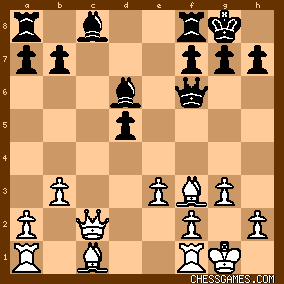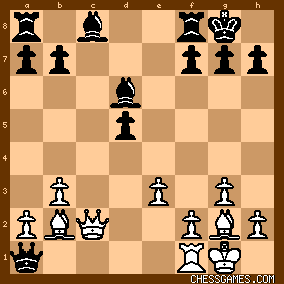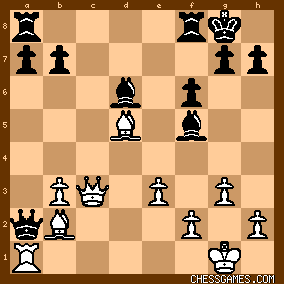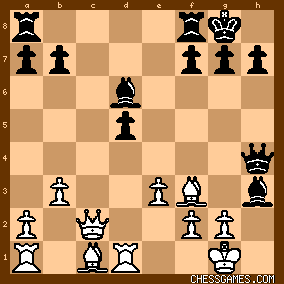|
< Earlier Kibitzing · PAGE 3 OF 3 ·
Later Kibitzing> |
| Oct-09-09 | | Marmot PFL: <14.g3? is easily refuted by 14...Qf6; FORKING the WB/f3 and the WR/a1> However after 15 Bxd5 Qxa1 16 Bb2 Qxf1+ (16...Qxa2 17 Qc3)17 Kf1 Bh3+ 18 Kg1 Rac8 19 Qe4 white looks fine |
|
Oct-09-09
 | | gawain: This was very instructive. Always. always look for hanging pieces. Minev must have been stunned after 14...Qf6. As <Dzechiel> says, this position just doesn't look dangerous for White. |
|
| Oct-09-09 | | YouRang: Well, I looked at 12...Nxf3+ 13.Bxf3 Qh4 14.h3, and from there I saw nothing to make be believe I had solved a puzzle. :-\ |
|
| Oct-09-09 | | JG27Pyth: Missed it. What a great puzzle though! |
|
Oct-09-09
 | | Jimfromprovidence: <LIFE Master AJ: To me, this was not much of a problem. 12...Nxf3+; 13.BxB/f3. (forced)
13...Qh4;
White has no choice, 14.g3? is easily refuted by 14...Qf6; FORKING the W/f3 and the W/a1. > Here is the text position after 14...Qf6.

click for larger viewSome overlooked the point I made yesterday evening, that 15 Bg2 removes the fork. If 15...Qa1, then 16 Bb2 traps the queen. 
click for larger view |
|
| Oct-09-09 | | randomsac: Cool way to be up a piece. I was trying to exploit the massive pawn hole with Bh3. |
|
| Oct-09-09 | | wals: Nikolay Minev - Jiri Fichtl, 13th olm final A 1958

click for larger viewAnalysis by Rybka 3 1-cpu:
1.  (-#4): 64.Ke2 Bc4+ (-#4): 64.Ke2 Bc4+
2.  (-#4): 64.Kd2 Qb2+ (-#4): 64.Kd2 Qb2+
How it may have ended. |
|
Oct-09-09
 | | LIFE Master AJ: <Jim from Providence.> I already thought of that.
I go ahead and take on a1, most masters consider two Rooks superior to a Queen. |
|
| Oct-09-09 | | NARC: What does Rybka think about 12. ... Qf6 instead of 12. ... Nxf3? I also wonder if black can play d4 directly instead of Bxh3 in the variation given where Rybka suggests Bxh3. Sometimes in IQP
positions one tosses the IQP first. |
|
Oct-09-09
 | | Sneaky: <Jim from Providence: Some overlooked the point I made yesterday evening, that 15 Bg2 removes the fork. If 15...Qa1, then 16 Bb2 traps the queen.> That's a very good point. It's NOT as easy as "and ...Qf6 forks the rook and bishop". It doesn't deserve the label of a "fork" if the forkee has some clever way to wriggle out of his problems, and ...Bb2! is exactly that wriggling move. <Life Master AJ> <I already thought of that. I go ahead and take on a1, most masters consider two Rooks superior to a Queen.> Yes and no. I suppose the line you are referring to is this one: 15.Bg2 (Jim's suggestion) Qxa1 ("go ahead and take on a1") 16.Bb2 Qxa2 17.Ra1 Qxa1+! ("two rooks are superior to a queen") 18.Bxa1 which gives us this 
click for larger viewMaybe Black is a little better--or maybe not, it's really unclear to me. Anyhow I'm not trying to assess that position, just wanted to say that it doesn't look like the final goal of a CG homepage puzzle. But the point is that it is a blunder to play 15...Qxa1? in that position, not because it loses, but because a CLEARLY winning move exists. Correct is 15...Bxf5! as in the game, ensuring at least the exchange. |
|
| Oct-09-09 | | NARC: Hell, I checked with xboard, toss the pawn to d4 at move 12 and party. But if it's more than 0.73 I leave to silicon.
Why am I thinking of hooters? |
|
| Oct-09-09 | | goodevans: I think today’s puzzle was quite tough for a Friday. Once you’d spotted the basic Q-forks-B-&-R theme you need to also spot that the immediate R capture leads to the Q being trapped and ... Anyway, please don’t mistake this for a complaint, merely an excuse for my only spotting half of the complications going on in the position. In fact I’ve really enjoyed yesterday’s puzzle and today’s and am in high expectations for what’s in store for tomorrow. |
|
| Oct-09-09 | | Patriot: <<LIFE Master AJ>: <Jim from Providence.>
I already thought of that.
I go ahead and take on a1, most masters consider two Rooks superior to a Queen.> I'm no master, but concluded the fork on rook and bishop were enough to win. I would definitely have gone into that position knowing that black has winning chances and certainly can't be losing. But on further inspection after 14...Qf6 15.Bg2, it must be a mistake playing 15...Qxa1 and trading the queen for two rooks. I have to believe black has more than that. Taking the rook is selling himself short. |
|
| Oct-09-09 | | David2009: Tis is my third post on what has proved a fascinating puzzle. I now agree with other kibitzers that 14 h3 seems best.
<RandomVisitor: [snip] Analysis by Rybka 3 (-0.73): 14.h3 Bxh3 15.Rd1 Bh2+ 16.Kf1 Rfc8 17.Qb2 Be6 18.Qd2 Be5 19.Bb2 Bd7 20.a4 Bf5 21.Rac1 Bxb2 22.Qxb2 Rxc1 23.Rxc1 d4 24.Kg1 dxe3 25.fxe3 Qe7 26.Qd4 a6 27.Rc5 Rd8> In this line Crafty prefers 16 ... Be5 e.g. 17 Bb2 Rac8 18 Qd2 Bxb2 19 Qxb2 Bf5 20 g3 Qh2
21 Rd2 Rfe8 21 Qd4 (if 21 Bxd5 Rcd8! and wins by direct attack- too many open lines) Be4 23 Bxe4 dxe4
24 Rad1 Qh1+ 25 Ke2 Qf3+ 26 Ke1 Rc6 27 Qd7 may hold the draw. I found this defence by a slow process of trial and error.
Crafty is good but not infallible and sometimes misses wins. Link to original puzzle: http://www.chessvideos.tv/endgame-t... Crafty can beat up the defence I suggested in my second post for White - pity. |
|
| Oct-09-09 | | johnlspouge: Friday (Difficult)
Minev vs J Fichtl, 1958 (12…?) Black to play and win.
Material: Even. The White Kg1 has 1 legal move. The Black Bs have better mobility than the White Bs and might contribute to a local superiority near the White K-side. White has a loose Ra1 and Qc2. The Black Kg8 is secured from check. Candidates (12...): Nxf3+, Qf6
12…Nxf3+
(1) 13.Bxf3 Qh4 (threatening 14…Qxh2#)
14.h3 [g3 Qf6 forks the loose Bf3 and Ra1, winning a piece] 14…Bxh3 15.gxh3
[15.Bxd4 Bxg2 and mate threats render Bg2 immune]
[else, drop an important P]
15…Qxh3 (threatening 16.Qh2# or 16.Qxf3)
Black is up at least 2P.
(2) 13.gxf3 Bh3 (threatening 14.Bxf1 or 15.Qg5+ 16.Qg7#) Black is up at least R for B. |
|
| Oct-09-09 | | johnlspouge: < <Sneaky> wrote: <Jimfromprovidence>: <[snip] 15 Bg2 removes the fork. If 15...Qa1, then 16 Bb2 traps the queen.> [snip] Anyhow I'm not trying to assess that position [snip] > I am not so squeamish :)
At 20 plies, Toga assigns +0.14 P to <Jfp>'s Q for 2R+P variation, hardly the stuff of a dream variation. I was curious, because I saw the possibility of a Q trap, but like <Patriot>, dismissed the trap as a real issue. The value of the Q for 2R trade still seems mysterious to me: sometimes, it is incredibly difficult to evaluate. |
|
| Oct-09-09 | | DarthStapler: I got the first two moves |
|
| Oct-09-09 | | patzer2: Today's Friday puzzle solution 12... Nxf3! leads to a small, but not clearly decisive, advantage for Black after the best defense 12...Bxf3 13.Bxf3 Qh4 14.h3! Bxh3 15. Rd1 Bh2+ 16. Kf1  per the 19-ply Rybka 3 analysis posted by <Random Visitor>. per the 19-ply Rybka 3 analysis posted by <Random Visitor>.After 14. g3? in the game continuation, Black wins with the double attack 14...Qf6  . . P.S.: In the Rybka 3 line, the combination wins a pawn with a small but clear advantage. |
|
| Oct-09-09 | | WhiteRook48: I tried 12...Nxf3+ 13 Bxf3 Qh4 15 g3 Qh3?! 16 Bg2! |
|
Oct-09-09
 | | JOE45: "Some overlooked the point I made yesterday evening, that 15 Bg2 removes the fork. If 15...Qa1, then 16 Bb2 traps the queen." Doesn't 16...Qxa2 17. Ra1 Bf5 18. e4 Rac8 drive the Q away so you get the exchange + pawns? |
|
Oct-09-09
 | | Jimfromprovidence: <JOE45> <15...Qa1, then 16 Bb2 traps the queen." Doesn't 16...Qxa2 17. Ra1 Bf5 18. e4 Rac8 drive the Q away so you get the exchange + pawns?> Luckily, white has 18 Qc3 instead, threatening Qxg7#.

click for larger view Now, 18...Qxa1+ is forced, because, 18...f6, for example, leads to 19 Bxd5+, below, losing the queen for black. 
click for larger view |
|
| Oct-09-09 | | RandomVisitor: After 12...Nxf3+ 13.Bxf3 Qh4 <14.h3> Bxh3 15.Rd1: 1: Nikolay Minev - Jiri Fichtl, 13th olm final A 1958

click for larger viewAnalysis by Rybka 3 : <22-ply> Final post... <1. (-0.72): 15...Rac8> 16.Qb2 Be6 17.g3 Qg5 18.Qe2 Qg6 19.e4 Be5 20.Ba3 Bxa1 21.Bxf8 dxe4 22.Bxe4 Bg4 23.Qe3 Qf6 24.f3 Be6 25.Bb4 Rd8 26.Rxd8+ Qxd8 27.Kg2 b6 28.Qf4 g6 29.g4 f6 2. (-0.64): 15...Rfc8 16.Qd2 Be6 17.Bb2 Qh2+ 18.Kf1 Rc6 19.Rac1 Bf8 20.Ke2 Rac8 21.Rxc6 bxc6 22.Qd3 Qh4 3. (-0.64): 15...Be6 16.Bb2 Rfc8 17.Qd2 Qh2+ 18.Kf1 Rc6 19.Rac1 Bf8 20.Ke2 Rac8 21.Rxc6 bxc6 22.Qd3 Qh4 (, 09.10.2009) |
|
| Oct-09-09 | | CHESSTTCAMPS: Both sides have completed their development except for the c-bishops, but black is on the move, so black has siezed the initiative at the price of an isolated d-pawn. White's Q is misplaced on c2, subject to tempo-gaining black moves such as a later Bc5 or Rac8. Most likely, white's last move was b3 and this looks like a mistake because it leaves the rook loose. Perhaps white has taken a risk to set a trap. In any case, black has a forcing line of play that sets up a fork and is fairly easy to find, but the complications after that are tricky. 12... Nxf3+
Simple and direct. The alternative 12.. Qf6 13.Bb2 Bc5 14.Qd2 neutralizes the indirect attack on the Ra1. Now A) 13.gxf3 Bh3 wins an exchange in view of the threat 14... Qg5+ B) 13.Bxf3 Qh4 14.g3 Qf6 creates the key position.
The black queen is forking the Bf3 and the Ra1, but can the Q escape from prison if she takes on a1? The alternatives on move 15 depend on how white chooses to protect the Bf3. First a quick look at the alternative on move 14. B.1) 14.h3 Bxh3! 15.gxh3 Qxh3 16.Rd1 (Bg2 Qh2#) Qxf3 is an easy win. B.1.1) 15.g3 Qf6 wins at least a piece.
B.1.2) 15.Rd1/e1 Rac1 and black has a pawn plus strong initiative. B.2) 15.Qe2? Qxa1 16.Bb2 Qxa2 and the BQ escapes via b3 or a6, with black a rook up. B.3) 15.Bxd5 Bf5! (Qxa1? 16.Bb2 Qxa2? 17.Qc3 forces Qxb2) 16.e4 Bh3! 17.Rd1 Rac8! 18.Qd2 (Qb1 Qf3 wins) Bb4!! 19.Qd4 (Qxb4 Qf3! 20.e5 Qxd1+ wins) Qxd4 20.Rxd4 Bc3 wins a rook. B.3.1) 16.Qb2/d2/e2 Be5! wins a piece without putting the Q in a bad spot B.3.2) 16.Qd1 Qxa1 wins a rook because white no longer has 17.Bb2 B.3.3) 17.Bb2 (or Re1) Qf3 18.e5 Qxd5 wins
B.3.4) 18.Qe2 Qxa1 19.Bb2 Bg4! 20.Qxg4 (B/Rxa1 Bxe2) Qxb2 wins B.4) 15.Bg2 Bf5 16.e4 Rac8! 17.Qd2 Be5 (safer than Qxa1 18.Bb2 Qxa2 19.Qd4) 18.Rb1 dxe4 with an extra pawn and control of the central files. Probably I've missed something simpler and more decisive in B.4, but the rest looks like the right track - time to check. |
|
| Oct-10-09 | | TheBish: Minev vs J Fichtl, 1958 Black to play (12...?) "Difficult"
This really was difficult, at least for me. Took me a long time to see the point. I knew it had something to do with the unprotected rook, but I just wasn't putting it together, until now. 12...Nxf3+!
I was looking at lines starting with 12...Qf6, but when I realized that Black has nothing after 13. Nd4, I realized I was going down the wrong path. 13. Bxf3
Obviously, 13. gxf3? allows 13...Bh3 with the threat of Qg5+. 13...Qh4!
I dismissed the first two or three times looking at this, until I saw a big point, which led me to pursue it again. Once I saw 14. g3 Qf6, forking two pieces, I knew I was on to something. But it's not so simple! Now: A) 14. g3 Qf6 15. Bxd5 (or 15. Bg2 Qxa1 16. Bb2 Bf5! 17. e4 Rac8! and the Black queen escapes or Black wins material, i.e. 18. Qxc8 Qxf1+, or 18. Qd2 Qxa2 19. exf5 and Black wins the exchange) 15...Bf5! 16. Qd2 (or 16. e4 Bh3 17. Rd1 Be5!, with dual threats of Qf3 and Bxa1, or 16. Qe2 Qxa1 17. Bb2 Bd3! [not 17...Qxa2 18. Ra1] leaving Black up a rook) 16...Be5, winning a piece. B) 14. h3 Bxh3! (threatening Bxg2!) and now:
B1) 15. gxh3 Qxh3 16. Rd1 Bh2+ 17. Kh1 Be5+ 18. Kg1 Qxf3! 19. Bb2 Rac8 20. Qd2 Bxb2 21. Qxb2 Rc6 22. Kf1 Rh6 23. Ke1 Rh1+ 24. Kd2 Qxf2+, and White will lose his queen for a rook (and then get mated) after 25. Kc3 (or 25. Kc1 Rxd1+) Rc8+ 26. Kb4 Qxb2 27. Rxh1 Rc4+ 28. Kb5 Qc3 29. bxc4 Qxc4+ 30. Ka5 b6#. B2) 15. g3 Qf6 16. Bg2 (or Bxd5 Qxa1 wins easily) Bxg2 17. Kxg2 Qxa1 18. Bb2 Qxa2 (or Rac8) 19. Ra1 Rac8! and Black wins, e.g. 20. Qxc8 Qxb2 21. Qc1 Qxc1 with a piece and two pawn advantage. |
|
Oct-23-21
 | | ChessCoachClark: Robert Timmer wrote books on castling that cover this game in detail as well as later games using themes it brings. The Timmer book that I own is Castling to Win! See pages 10 to 11. Worth a look. |
|
 |
 |
|
< Earlier Kibitzing · PAGE 3 OF 3 ·
Later Kibitzing> |





